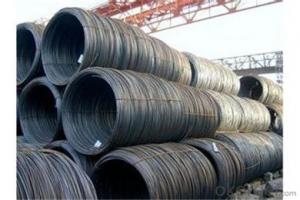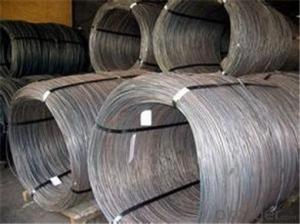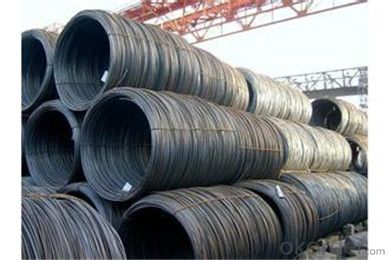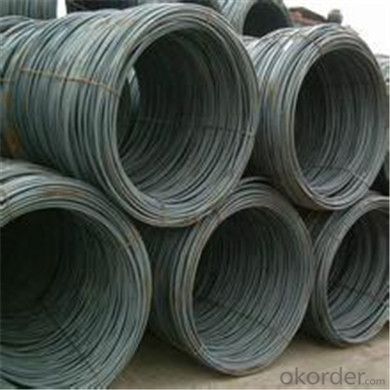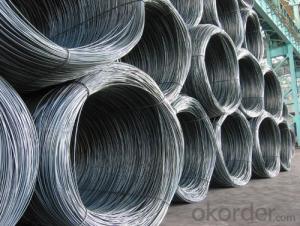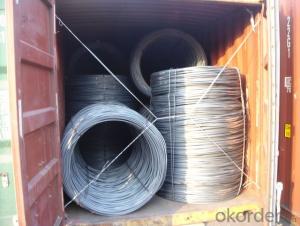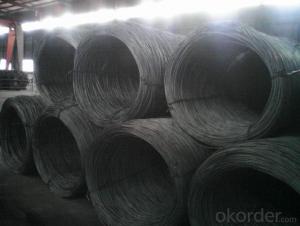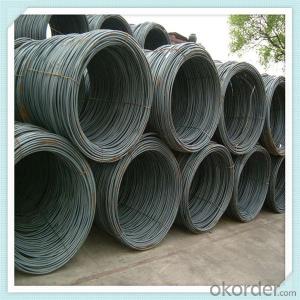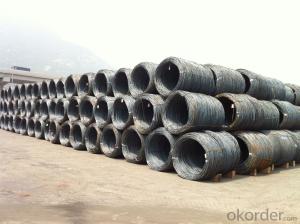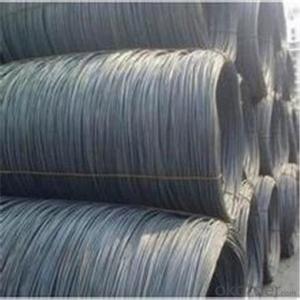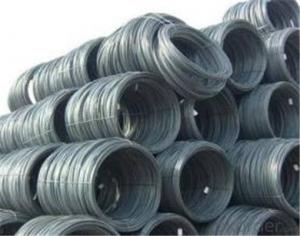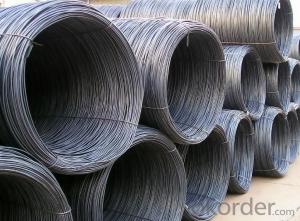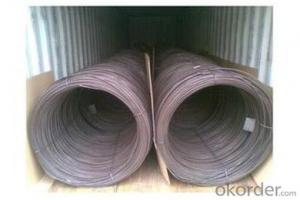SAE1008 Steel Wire rod 5.5mm with Best Quality
- Loading Port:
- Tianjin
- Payment Terms:
- TT OR LC
- Min Order Qty:
- 60 m.t.
- Supply Capability:
- 455566666 m.t./month
OKorder Service Pledge
OKorder Financial Service
You Might Also Like
Specification
Description of wire Rod:
wire rod:
Grade:SAE1006B/SAE1008B/SAE1018B
Size:5.5/6.5/7/8/9/10/11/12mm
Festures of wire Rod:
· fasteners, bolts, rivets, screws,
· general purpose wires,
· electrode wires, industrial wires, agriculture wires,
· bush wires, chain rivet wires,
· detonator wire,
· Umbrella ribs, upholstery wires, cycle spokes, needle wires, heald wires, staple pin Wire, safety pin wires
· ACSR wires, earth wires,
· tyre and hose reinforcement wires,
Specifications of wire Rod:
Grade | Chemical Composition(%) | |||||
C | Mn | Si | S | P | Cr | |
SAE1006B | 0.03~O.07 | ≤0.32 | ≤0.30 | ≤0.045 | ≤0.040 | 0.3-0.35 |
Mechanical properties | ||||||
Yield strength(N/mm2) | Tensile strength(N/mm2) | Elongation(%) | ||||
250-280 | 350-380 | ≥32 | ||||
Grade | Chemical Composition(%) | |||||
C | Mn | Si | S | P | Cr | |
SAE1008B | 0.10max | 0.3~O.50 | 0.15max | 0.050max | 0.040 max | 0.3-0.35 |
Mechanical properties | ||||||
Yield strength(N/mm2) | Tensile strength(N/mm2) | Elongation(%) | ||||
≥195 | 315-430 | ≥30 | ||||
Images of wire Rod:
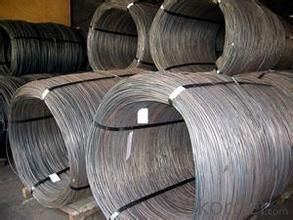
FAQ:
1. What is your package?
Packing situation: standard seaworthy packing or as customer required.
2. How long is the lead time?
Delivery time: 45 days after order confirmed.
3. What payment term do you accept?
Payment: T/T or L/C at sight.
- Q: How is steel wire rod used in the production of wire jewelry?
- Steel wire rod is used in the production of wire jewelry as the primary material for creating various types of wire components, such as jump rings, clasps, and wire wraps. It provides strength, durability, and flexibility, allowing jewelry makers to shape and manipulate the wire into intricate designs. Additionally, steel wire rod can be plated or coated with different metals to enhance its appearance and prevent tarnishing, offering a wide range of options for creating beautiful and long-lasting wire jewelry pieces.
- Q: What are the different testing standards for steel wire rod?
- There are several testing standards for steel wire rod, including ASTM A510, ASTM A370, ASTM E8/E8M, ASTM E290, and ISO 6892-1. These standards outline various mechanical and physical tests to evaluate the quality, strength, and other properties of steel wire rod, such as tensile strength, yield strength, elongation, hardness, and chemical composition.
- Q: What are the environmental considerations associated with steel wire rod production?
- The environmental considerations associated with steel wire rod production include energy consumption, greenhouse gas emissions, water usage, waste generation, and potential impact on surrounding ecosystems. The production process involves high energy requirements, mainly from electricity and fuel consumption, contributing to carbon dioxide emissions. Water is often used for cooling and cleaning purposes, leading to water scarcity concerns and potential contamination. Waste generation includes byproducts like slag and scale, which require proper disposal or recycling to minimize environmental impact. Additionally, the extraction of raw materials, such as iron ore and coal, can lead to habitat destruction and biodiversity loss. However, advancements in technology and sustainable practices are being implemented to reduce these environmental impacts and promote more eco-friendly steel production.
- Q: How is steel wire rod used in the manufacturing of wire for fishing lines?
- Steel wire rod is an essential component in the manufacturing of wire for fishing lines as it provides the necessary strength and durability required for fishing activities. It is first drawn through a series of dies to reduce its diameter to the desired thickness, and then coated with a protective layer to prevent corrosion. The resulting wire is then further processed and twisted to create fishing lines of various strengths and lengths, ensuring reliable performance and resilience while fishing.
- Q: How is steel wire rod used in the manufacturing of wire cloths?
- The production of wire cloths relies heavily on steel wire rod, an indispensable component. This material undergoes a series of processes to transform it into fine wires. Initially, the steel wire rod is drawn through a die, reducing its diameter and increasing its length. This drawing process enhances the wire's strength and flexibility. Once the wire has been drawn, it is woven or knitted together to form the wire cloth. Different weaving or knitting patterns can be employed to achieve various mesh sizes and configurations, depending on the intended application of the wire cloth. The durability and tensile strength of the steel wire rod ensure that the resulting wire cloth is robust and capable of withstanding the demands of its designated usage. Wire cloths have broad applications across multiple industries, including filtration, sieving, screening, and separation processes. For example, the mining industry commonly employs wire cloths for mineral sieving and separation. In construction, wire cloths serve as reinforcing materials in concrete structures, enhancing their strength and durability. The food and beverage industry utilizes wire cloths for filtration, guaranteeing the elimination of impurities and contaminants. In conclusion, steel wire rod plays a pivotal role in the manufacturing of wire cloths. It serves as the essential raw material, which is then transformed into fine wires that are woven or knitted to create wire cloths for diverse industrial applications.
- Q: What are the common production processes for ruthenium-coated steel wire rod?
- The common production processes for ruthenium-coated steel wire rod typically involve several key steps. First, the steel wire rod is usually cleaned and prepared to remove any impurities or surface contaminants. Next, a coating material, in this case, ruthenium, is applied to the surface of the steel wire rod using various methods such as electroplating or chemical vapor deposition. This coating process helps improve the wire rod's corrosion resistance, durability, and other desired properties. After the ruthenium coating is applied, the wire rod is typically inspected for quality and undergoes any necessary finishing processes, such as annealing or polishing, to achieve the desired final product.
- Q: What are the different types of steel wire rod surface treatment chemicals?
- There are several different types of steel wire rod surface treatment chemicals that are commonly used in various industries. These chemicals are designed to enhance the properties of the steel wire rod and provide protection against corrosion. Some of the most common types of surface treatment chemicals include: 1. Phosphating chemicals: Phosphating is a common surface treatment process that involves the application of a phosphate coating to the steel wire rod. This coating helps improve the adhesion of paints and other coatings, provides corrosion resistance, and enhances the overall appearance of the wire rod. 2. Pickling chemicals: Pickling is a process that involves the removal of scale and oxides from the surface of the steel wire rod. Pickling chemicals, such as hydrochloric acid or sulfuric acid, are used to dissolve these impurities and leave a clean and smooth surface. 3. Passivation chemicals: Passivation is a chemical process used to remove free iron or iron oxide from the surface of the steel wire rod. This helps to enhance the corrosion resistance of the wire rod by creating a protective oxide layer. 4. Chromate conversion coatings: Chromate conversion coatings are often used as a post-treatment for phosphating or pickling processes. These coatings provide additional corrosion resistance and improve the adhesion of paints or other coatings. 5. Anti-corrosion oils: Anti-corrosion oils are applied to the surface of the steel wire rod to provide temporary protection against corrosion during storage or transportation. These oils form a thin film that helps to prevent moisture and other corrosive substances from reaching the surface of the wire rod. It is important to note that the choice of surface treatment chemical depends on the specific requirements of the steel wire rod and the intended application. Different industries may have their own unique set of requirements and may use different types of surface treatment chemicals accordingly.
- Q: What are the common production processes for galvanized steel wire rod?
- The common production processes for galvanized steel wire rod include wire drawing, heat treatment, galvanization, and coiling.
- Q: What are the common storage methods for steel wire rod?
- The common storage methods for steel wire rods include stacking them horizontally on pallets, using steel racks or shelves to store them vertically, or bundling and tying them together to hang from overhead racks or hooks.
- Q: How is steel wire rod used in the manufacturing of wire mesh?
- Steel wire rod is used in the manufacturing of wire mesh by first being drawn through a series of dies to reduce its diameter and increase its length. This process, known as wire drawing, results in a thin, continuous wire that is then woven or welded together to create wire mesh. The high tensile strength and durability of steel wire rod make it an ideal material for producing wire mesh, which is widely used in various applications such as fencing, construction, and filtration.
Send your message to us
SAE1008 Steel Wire rod 5.5mm with Best Quality
- Loading Port:
- Tianjin
- Payment Terms:
- TT OR LC
- Min Order Qty:
- 60 m.t.
- Supply Capability:
- 455566666 m.t./month
OKorder Service Pledge
OKorder Financial Service
Similar products
Hot products
Hot Searches
Related keywords
